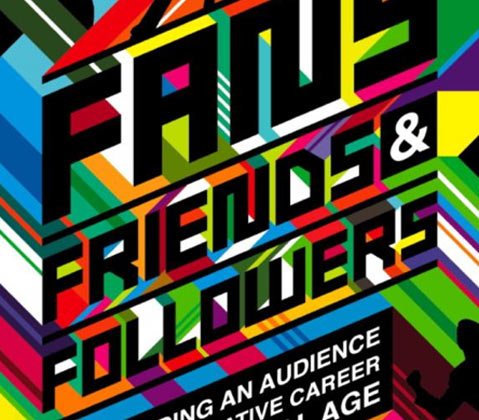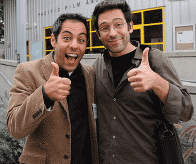

An Exclusive Excerpt from Friends, Fans and Followers

Fans, Friends and Followers: Building an Audience and a Creative Career in the Digital Age may be this year’s must-read book for anybody who makes creative content on the Internet. Everybody, including the Brewmasters, constantly preaches that the future for artists is on the Internet, but how exactly can an artist establish a fan base, generate revenue, and create a reputation on the Internet?
Scott Kirsner, Variety writer and editor of the invaluable CinemaTech blog, breaks it down in his new book by offering case studies of thirty visual artists, comedians, animators, documentary filmmakers, musicians and writers. I haven’t seen the book yet, but I’m sure that it’s not going to offer many easy-to-follow formulas. Even the traditional media gatekeepers, with their hundreds of millions of dollars, have yet to figure out a formula for taming the Internet. What the book will likely show though is that there are countless different models that indie media makers, including animators, can use to connect with an audience online. Unlimited opportunities await artists on the Internet, and this book should serve as an invaluable handbook for any creative soul who is brave enough to venture into this uncharted frontier.
The website for Fans, Friends and Followers offers the book for purchase in multiple formats including Kindle and PDF, and a paperback version is available on Amazon.
The author, Scott Kirsner, has kindly provided Cartoon Brew an exclusive excerpt from an interview in the book with JibJab founders Evan and Gregg Spiridellis, and how they’ve found unconventional ways of generating revenue from their animation work:
 Gregg Spiridellis: We released a video in October 2004, “Good to be in DC,” that premiered on the “Tonight Show.” At 10 PM on the day that played on “The Tonight Show,” Evan mocked up a DVD cover in PhotoShop, and I set up a Yahoo Store. The “Today Show” was coming the next day to talk to us, and we wanted to mention that we were selling our stuff on DVDs. During that interview, we held up the fake DVD and mentioned that we were selling them. We sold 10,000 DVDs. We told people they wouldn’t ship for six weeks, but we wound up making them in four. It was $10 for less than four minutes of content.
Gregg Spiridellis: We released a video in October 2004, “Good to be in DC,” that premiered on the “Tonight Show.” At 10 PM on the day that played on “The Tonight Show,” Evan mocked up a DVD cover in PhotoShop, and I set up a Yahoo Store. The “Today Show” was coming the next day to talk to us, and we wanted to mention that we were selling our stuff on DVDs. During that interview, we held up the fake DVD and mentioned that we were selling them. We sold 10,000 DVDs. We told people they wouldn’t ship for six weeks, but we wound up making them in four. It was $10 for less than four minutes of content.
We also sold downloads for people who wanted to play the videos in full-screen, high-resolution. We sold them through our own online store, without DRM [digital rights management], for $1.99.
Evan Spiridellis: It was definitely the “Today Show” that moved most of the DVDs, but there was one day when we went to a bunch of satellite studios, like Fox and MSNBC, and at every interview, we lifted up this fake DVD. Our e-mail list went from 130,000 to 500,000 really quick, and in the two years after “This Land,” we got to 700,000. Today, it’s just over four million people.
GS: After “This Land” came out [in July 2004], our business model was to license content to people like Yahoo. Video didn’t move around; it tended to stay in one place. Then YouTube came along and blew up that idea. You couldn’t control video anymore. It forced us to say, “OK, the original JibJab videos that we produce are no longer how we’re gonna make revenue. They’re a marketing opportunity.”
At first, we thought that advertising would be the way we’d go. But the more we looked at that, we realized that even if every video we made reached five million people, which is a baseline for us — “Time for Some Campaigning” is over 15 million now — that would generate $100,000 in ad revenue in the best case. And we’re spending about $75,000 to make the videos. Where’s the profit, where’s the scale?
ES: And if you even have a near-miss instead of a real hit, you’re in the red.
GS: In 2006, we came to the realization that an ad model wasn’t going to cut it. We’d taken venture capital money at that point.
We happened to look at American Greetings’ financials. They’re a public company. They have an $85 million business in online greeting cards. We said, “This is content. We do content.”
But Evan said, “There’s no f***ing way I’m making JibJab an e-card company.”
ES: But just because the bar was so low with e-cards didn’t mean it had to stay there.
GS: We felt we could create new expectations, new formats.
ES: And we’re also innovating our production model, creating a virtual studio. We look at blogs, and see that talent is everywhere. We might find a great writer in New York, and a voice guy in San Francisco, and an artist in Italy. Our job is to pull together these creative SWAT teams. A two or three or four-person team can produce great content, and they share in the revenue that gets generated by that content.
GS: The idea that we’re going to hit some sort of steady model is a false hope. You’ve just got to keep moving. We’ve had forty business models in nine years. I don’t see it slowing down at all.
ES: We had pitched a feature film to a major studio, right before we raised venture capital money. It was green-lit. But we were asking ourselves, “Do we want to go forward and be Evan and Gregg, these two creators working with a studio, or do we want to build something bigger, like a Disney or a Henson?”
We are just fiercely independent guys. You take studio money, and as much as they love you, you’re working for somebody. If they say, “Make those purple shoes red,” well, you’ve got a boss. And with JibJab, we got used to going directly to our audience.
GS: We innovate, we produce, we release, we get the response. The idea of spending two or three years on one thing, and not knowing how much support it would get when it was released — it just didn’t feel like the right time.

.png)